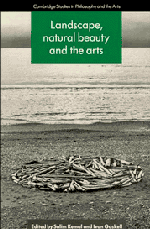Book contents
- Frontmatter
- Contents
- List of contributors
- Editors' acknowledgments
- 1 Nature, fine arts, and aesthetics
- 2 Natural beauty without metaphysics
- 3 Trivial and serious in aesthetic appreciation of nature
- 4 The public prospect and the private view: the politics of taste in eighteenth-century Britain
- 5 Landscape in the cinema: the rhythms of the world and the camera
- 6 The touch of landscape
- 7 Desert and ice: ambivalent aesthetics
- 8 Gardens, earthworks, and environmental art
- 9 Comparing natural and artistic beauty
- 10 Appreciating art and appreciating nature
- 11 The aesthetics of art and nature
- 12 On being moved by nature: between religion and natural history
- Index
11 - The aesthetics of art and nature
Published online by Cambridge University Press: 03 May 2011
- Frontmatter
- Contents
- List of contributors
- Editors' acknowledgments
- 1 Nature, fine arts, and aesthetics
- 2 Natural beauty without metaphysics
- 3 Trivial and serious in aesthetic appreciation of nature
- 4 The public prospect and the private view: the politics of taste in eighteenth-century Britain
- 5 Landscape in the cinema: the rhythms of the world and the camera
- 6 The touch of landscape
- 7 Desert and ice: ambivalent aesthetics
- 8 Gardens, earthworks, and environmental art
- 9 Comparing natural and artistic beauty
- 10 Appreciating art and appreciating nature
- 11 The aesthetics of art and nature
- 12 On being moved by nature: between religion and natural history
- Index
Summary
The title of this essay masks a deliberate ambiguity, one that is, in fact, its central issue. Few would deny the possibility of obtaining aesthetic satisfaction from both works of art and from nature, customarily in the case of the first and under certain conditions in the other. But what sort of satisfaction is this, and is it the same kind in nature as in art?
The usual course, perhaps the most intuitively obvious, is to recognize that aesthetic value exists in both domains but for historical and philosophical reasons to find, like Diffey and Carlson, that the kind of appreciation each encourages is essentially different. Another possibility is to join Ross in associating contemporary environmental art with seventeenth- and eighteenth-century gardens, then regarded as a high art, demonstrating a unity of art and nature in both, and implying that they share a common aesthetic. A third possibility, the converse of this, is to take environmental appreciation as the standard and to reinterpret the artistic aesthetic by the natural. The question hidden in my title, then, is whether there is one aesthetic or two, an aesthetic that encompasses both art and nature or one aesthetic that is distinctively artistic and another that identifies the appreciation of natural beauty.
This is more than a question in the grammar of number, and it is, in my judgment, more than a minor issue in aesthetics.
- Type
- Chapter
- Information
- Landscape, Natural Beauty and the Arts , pp. 228 - 243Publisher: Cambridge University PressPrint publication year: 1993
- 29
- Cited by



